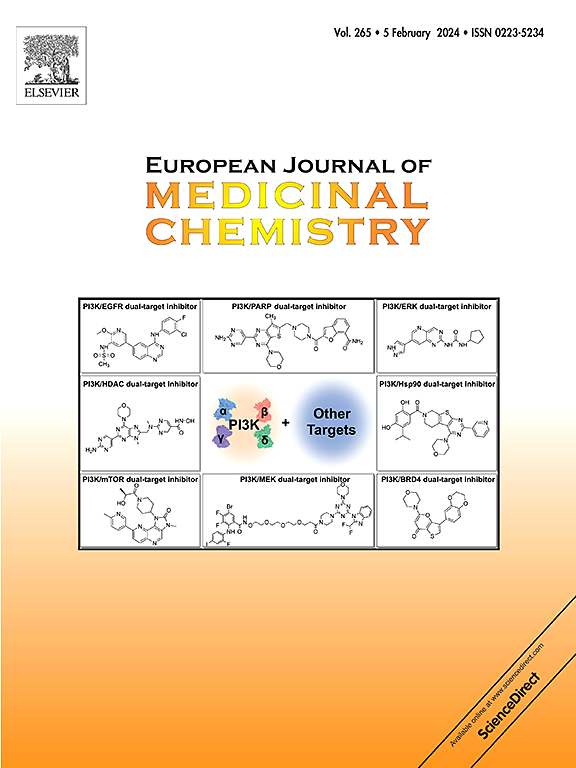N-(3-Hydroxyphenyl)-3,8-diazabicyclooctanes as opioid receptors probes. 1. Investigation of the phenolic hydroxyl group
IF 5.9
2区 医学
Q1 CHEMISTRY, MEDICINAL
引用次数: 0
Abstract
N-(3-Hydroxyphenyl)-3,8-diazabicyclooctanes represent a novel class of synthetic opioids with potent activity and a distinct pharmacological profile. The prototype of this class, atoxifent, exhibits strong opioid receptor activity while minimizing severe respiratory depression, distinguishing it from fentanyl. To gain deeper insight into ligand-receptor interactions and the factors influencing functional activity, we systematically investigated the role of the phenolic hydroxyl group. Our approach focused on (1) assessing hydrogen bonding interactions with opioid receptors, (2) modulating ionization via pKa adjustments, and (3) exploring bioisosteric replacements. In vitro assay showed that 3-amino (11), 3-cyclopropyl sulfonamide (12), and 3-carboxamido (13) derivatives retained high MOR agonist activity. Notably, 13 displayed approximately 2.4 times greater in vitro metabolic stability than atoxifent. In vivo antinociceptive studies showed that 11, 12, and 13 act as partial agonists. These findings offer valuable insight into how N-(3-hydroxyphenyl)-3,8-diazabicyclooctanes interact with opioid receptors.


N-(3-羟基苯基)-3,8-重氮杂环辛烷作为阿片受体探针。酚羟基的研究
N-(3-羟基苯基)-3,8-重氮杂比环辛烷是一类具有强大活性和独特药理特征的新型合成阿片类药物。这类药物的原型atoxifent表现出强烈的阿片受体活性,同时将严重的呼吸抑制降到最低,与芬太尼区分开来。为了更深入地了解配体与受体的相互作用以及影响功能活性的因素,我们系统地研究了酚羟基的作用。我们的方法集中在(1)评估与阿片受体的氢键相互作用,(2)通过pKa调节电离,以及(3)探索生物等阻替代。体外实验表明,3-氨基(11)、3-环丙基磺酰胺(12)和3-羧胺(13)衍生物具有较高的MOR激动剂活性。值得注意的是,13的体外代谢稳定性是atoxent的2.4倍。体内抗感受性研究表明,11、12和13是部分激动剂。这些发现对N-(3-羟基苯基)-3,8-重氮杂环辛烷如何与阿片受体相互作用提供了有价值的见解。
本文章由计算机程序翻译,如有差异,请以英文原文为准。
求助全文
约1分钟内获得全文
求助全文
来源期刊
CiteScore
11.70
自引率
9.00%
发文量
863
审稿时长
29 days
期刊介绍:
The European Journal of Medicinal Chemistry is a global journal that publishes studies on all aspects of medicinal chemistry. It provides a medium for publication of original papers and also welcomes critical review papers.
A typical paper would report on the organic synthesis, characterization and pharmacological evaluation of compounds. Other topics of interest are drug design, QSAR, molecular modeling, drug-receptor interactions, molecular aspects of drug metabolism, prodrug synthesis and drug targeting. The journal expects manuscripts to present the rational for a study, provide insight into the design of compounds or understanding of mechanism, or clarify the targets.

 求助内容:
求助内容: 应助结果提醒方式:
应助结果提醒方式:


